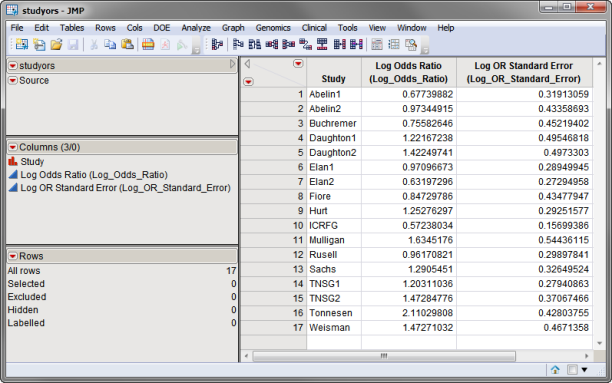Process Description
Meta-Analysis
This process performs a meta-analysis of multiple studies by combining p-values or effects for a particular test from the studies and calculating a combined p-value.
Results can be combined using one of three methods:
The first and second methods weight effects, such as regression coefficients or log odds ratios, from the studies by the inverse variance, calculated as the inverse square of the Standard Error Variable , and calculate a z-score based on the weighted combined effect and its standard error.
| • | When the random effects model is selected, the weights include an estimate of the between-study variance (DerSimonian and Laird, 1986). |
| • | The fixed effect model assumes that this variance is 0. When either inverse variance method is selected, a forest plot is displayed and also heterogeneity statistics are included in the output to indicate which model is appropriate. |
The third method uses p-values from the studies, converts them to z-scores and then combines the z-scores signed by the selected Effect Variable and weighted by the square root of the sample size (Stouffer et al., 1949).
What do I need?
There should be one data set containing p-values, effects, or both, for the studies in the analysis. Each row of the input data set corresponds to a study, and this data set must contain a Study ID Variable, and either:
| • | an Effect Estimate or Direction Variable and a Standard Error Variable (for the first two methods), or |
| • | a p-Value Variable and a Sample Size Variable (for the third method) |
To perform meta-analysis on multiple effects, an Effect ID Variable can be selected as well.
The studyors.sas.sas7bdat data set is shown below:

This Study, Log Odds Ratio, and Log OR Standard Error columns of this data set can be specified as the Study ID Variable, Effect Estimate or Direction Variable and Standard Error Variable, respectively, for running either of the inverse variance analysis methods.
For detailed information about the files and data sets used or created by JMP Genomics software, see Files and Data Sets.
Output/Results
The output generated by this process is summarized in a Tabbed report. Refer to the Meta-Analysis output documentation for detailed descriptions and guides to interpreting your results.